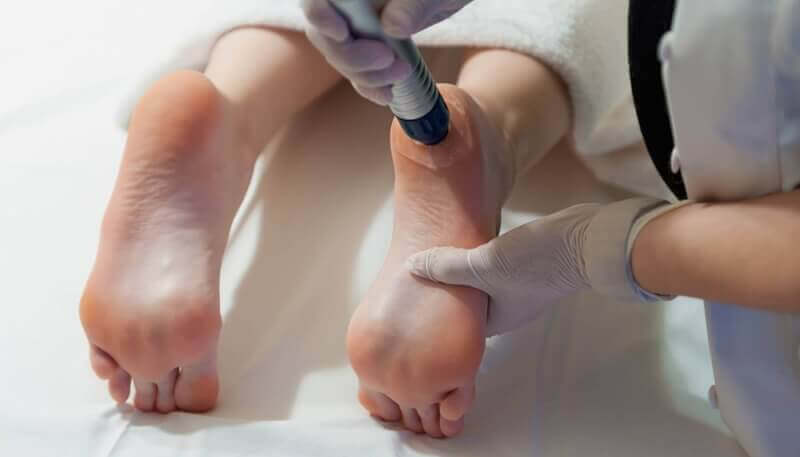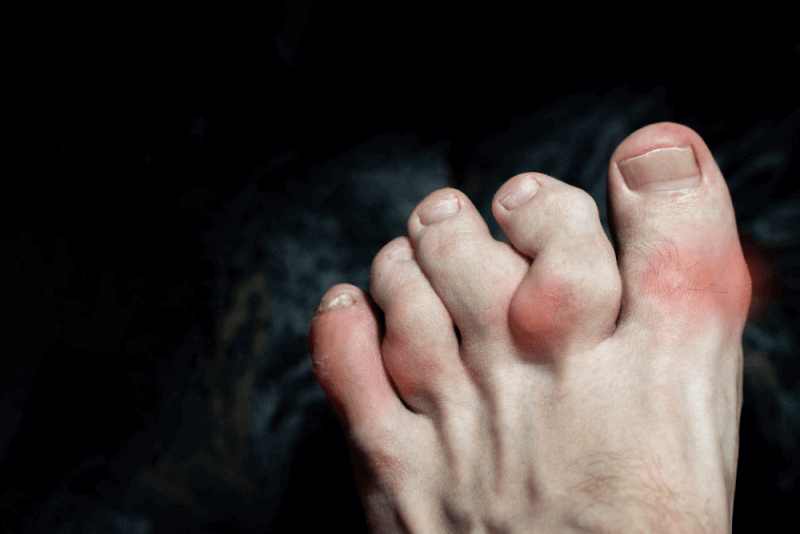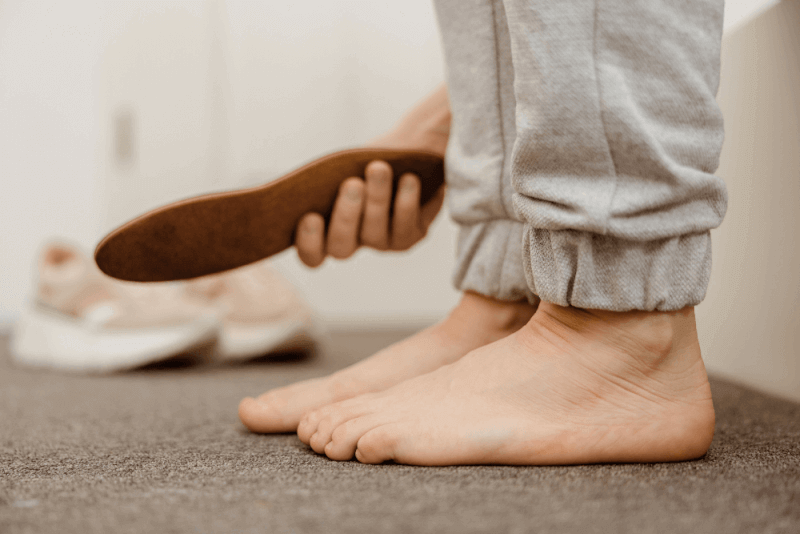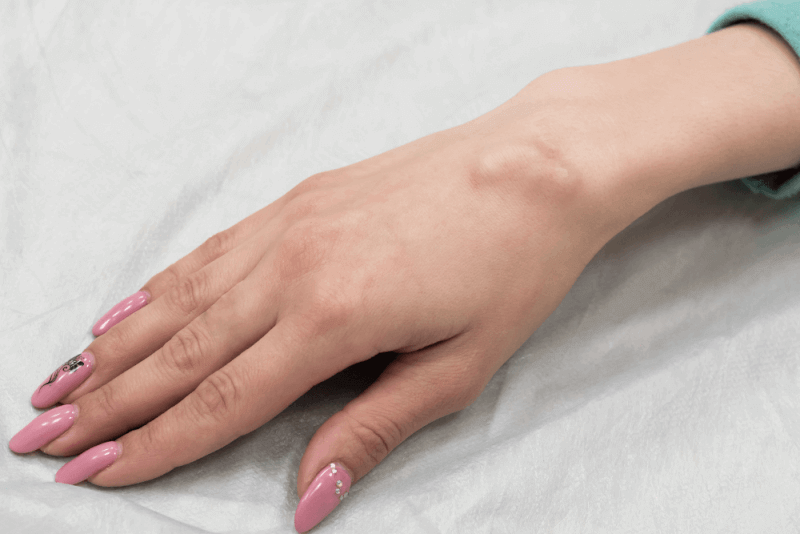30-Second Summary
- Heel spurs are bony protrusions that form at the junction of the heel bone and the plantar fascia.
- They can develop due to excessive pressure or trauma to the foot.
- Pain typically occurs with the first steps in the morning or after prolonged standing.
- Treatment options for heel spurs include rest, ice therapy, orthotics, shock-absorbing shoes, anti-inflammatory medications, extracorporeal shock wave therapy (ESWT), prolotherapy, PRP, acupuncture, steroid injections, and surgery.
- There are also some exercises you can do at home to help stretch and strengthen the foot muscles.
Heel spurs, which usually start at the front of the heel and can spread to other parts of the foot, are referred to as osteophytes in medical literature. Heel spurs, typically about 0.5 cm in size, are not always visible from the outside. These spurs often cause pain when patients take their first steps in the morning or after getting up from a sitting position, making it difficult for them to put weight on their feet.
What Is a Heel Spur?
A heel spur is a sharp, bony growth that develops on the heel bone. These structures, which form due to calcium deposits under the heel bone, also known as the calcaneus, can be seen on X-rays as protrusions measuring about one to one and a half centimeters from the heel. If not visible on X-rays, the condition is referred to as heel spur syndrome.
Heel spurs can develop due to underlying health issues but may also occur independently. They may appear at the front of the heel, just below the arch, or at the back of the heel. Heel spurs at the back are usually associated with inflammation of the Achilles tendon, known as Achilles tendinitis, which causes heel pain when pressure is applied to the front of the foot. Heel spurs at the front of the heel are often linked to plantar fasciitis, an inflammation of the plantar fascia, the connective tissue that runs from the heel to the toes.
Causes of Heel Spurs
Heel spurs develop due to calcium deposits forming under the heel bone. These deposits result from chronic strain and repeated tearing of muscles, soft tissue tendons, or the plantar fascia, leading to localized inflammation.
Factors That Increase Heel Spur Risk
- Being overweight
- Wearing shoes that do not fit the foot's anatomy
- Wearing shoes that do not support the arch of the foot
- Walking or running on hard surfaces
- Abnormal walking patterns that put excessive stress on the heel bone, heel, or ligaments
Other Risk Factors Related to Plantar Fasciitis
As people age, the elasticity of the plantar fascia decreases, and the cushioning tissue that protects the heel becomes thinner, increasing the risk of heel spurs.
In women, another factor that contributes to the increase in heel spurs is damage to soft tissue caused by heel injuries or sprains.
People who spend a significant part of their day standing are also at higher risk of developing heel spurs. Additionally, heel spurs are more common in individuals with diabetes.
Heel spurs are also more common in people who engage in short, frequent physical activities and in those with high arches or flat feet.
Medical conditions that increase the risk of heel spurs include:
- Achilles tendinitis
- Plantar fasciitis
- Diffuse idiopathic skeletal hyperostosis
- Ankylosing spondylitis
- Reactive arthritis
Symptoms of Heel Spurs
Heel spurs are often asymptomatic. However, some patients experience chronic or intermittent pain, which is due to inflammation at the site of the heel spur. Pain during walking or running is usually caused not by the heel spur itself but by inflammation around it.
The pain associated with heel spurs is often described as a stabbing or sharp pain, especially in the morning or after sitting for long periods. Other symptoms of heel spurs include:
- Sensitivity in the heel when walking barefoot
- A small, visible protrusion under the heel
- Increased warmth around the affected area
- Swelling or inflammation in front of the heel
How Is a Heel Spur Diagnosed?
The only way to confirm the presence of a heel spur is by taking an X-ray. A diagnosis of a heel spur is made when the bony protrusion is visible on the X-ray. Heel spurs, which often cause no symptoms, are usually diagnosed incidentally when X-rays are taken for other reasons.
Treatment of Heel Spurs
The primary goal of heel spur treatment is to reduce the pressure on the foot. Additionally, treatment aims to alleviate pain and address any inflammation that may be present.
Rest
Rest helps to reduce the pressure on the heel spur, allowing the swelling to subside and the inflammation to decrease.
Ice Therapy
Applying ice to the affected area helps reduce swelling and pain associated with the heel spur.
Orthotic Devices
Orthotics, which are ring-shaped inserts used inside the shoe, help reduce the pressure on the heel.
Shock-Absorbing Athletic Shoes
Wearing athletic shoes with shock-absorbing features reduces the pressure on the soft tissues in the foot and alleviates pain.
Anti-Inflammatory Medications
These medications are used to suppress the inflammation that causes heel spurs.
Extracorporeal Shock Wave Therapy (ESWT)
High-energy sound waves are directed to the affected area to promote healing of the plantar fascia.
Heel Spur Injection Therapy
Before opting for injection therapy, first-line treatments must have failed. If initial methods are insufficient, cortisone or PRP injections may be administered. Cortisone injections are often preferred. If pain persists after the first injection, a second injection may be considered after 10-15 days.
Prolotherapy
An irritant agent such as dextrose is injected into the damaged soft tissue to accelerate healing.
PRP
A natural substance derived from the patient's own blood is injected into the heel to speed up healing.
Steroid Injections
Steroid injections are used to reduce pain and swelling in the area affected by the heel spur. They are used when anti-inflammatory medications are insufficient for treatment.
Side Effects of Heel Spur Injections
Heel spur injections are typically recommended no more than 2-3 times. Repeated cortisone injections may cause tearing of the heel spur.
Acupuncture
Sterile needles inserted into specific points on the body stimulate the body's healing mechanism, promoting recovery of the affected area.
Surgery
Surgery is rarely performed for heel spurs. If symptoms persist despite 9-12 months of treatment, surgery may be considered. Procedures may include releasing the plantar fascia or removing the heel spur.
Summary of Surgery
Duration: 30 minutes to 1 hour
Anesthesia: Local, General
Hospital Stay: 1 Day
Return to Work: 2-6 Weeks
Heel Spur Exercises
Heel spurs can develop due to the constant contraction of short muscles in the foot and calf. Exercises that help stretch and lengthen the soft tissues in this area can alleviate symptoms.
Other Treatments for Heel Spurs
Epsom salt, which contains magnesium sulfate, can be used to aid in the treatment of heel spurs. Soaking the foot in water with Epsom salt may be beneficial.
Foot massages with lavender or rosemary oil can help reduce pain due to their anti-inflammatory properties.
Apple cider vinegar, known for its ability to remove excess calcium from bones, is another remedy used in heel spur treatment. The foot can be soaked in water with added apple cider vinegar, or a towel soaked in apple cider vinegar can be applied to the heel spur.
Finally, baking soda can also be used to help treat heel spurs. A paste can be made by mixing half a measure of baking soda with one measure of water, which is then applied to the heel spur with a massage.
Heel Spur Slippers
Heel spur slippers can make walking or standing more comfortable by reducing the pain caused by heel spurs. These slippers provide support to the foot's anatomy with various support points, helping to reduce the pain felt in the heel and making it easier for patients to move comfortably.
Where Does Heel Spur Pain Radiate?
Heel spur pain is often described as stabbing. Some patients may also experience a burning sensation in addition to the pain. While heel spur pain can vary in intensity, it typically occurs in the heel area, with some cases extending towards the middle of the foot.













